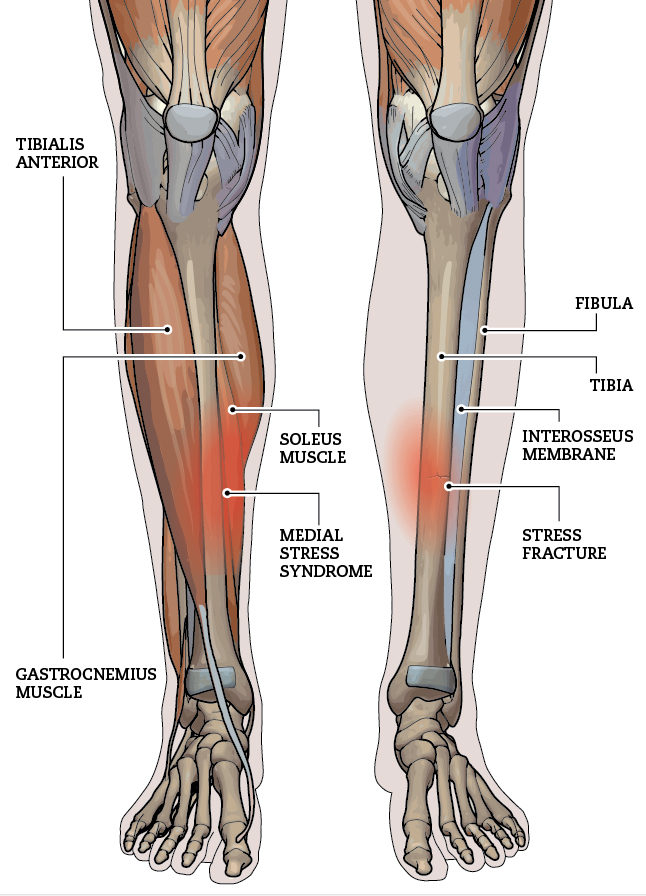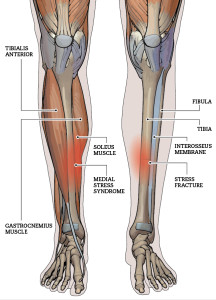Tibial stress injuries

To avoid a bigger problem, don’t ignore shin pain.
By Theresa Wallace
The dreaded tibial stress fracture is one of the most feared and most common injuries that runners experience. They are difficult to diagnose and require lots of recovery time. That’s why many runners sink into a state of denial when shin pain creeps in. But an undiagnosed tibial issue can quickly go from derailing a workout or two to ending your season.
 The first sign of a problem is usually shin pain. Since it takes time to get an appointment, a runner typically shows up at the doctor two to three weeks after the onset of symptoms, according to Dr. Linda Thyer, Athletics Canada medical director. She says although some physicians may order an X-ray to rule out other more severe potential problems, such as a tumour, the X-ray won’t actually show a new stress injury. The next step is often a bone scan, mainly because it’s quicker to obtain than the more thorough mri. Occasionally, CT (computed tomography) scans are used, but Thyer says they’re more often ordered to diagnose deeper, more complicated fractures of the foot.
The first sign of a problem is usually shin pain. Since it takes time to get an appointment, a runner typically shows up at the doctor two to three weeks after the onset of symptoms, according to Dr. Linda Thyer, Athletics Canada medical director. She says although some physicians may order an X-ray to rule out other more severe potential problems, such as a tumour, the X-ray won’t actually show a new stress injury. The next step is often a bone scan, mainly because it’s quicker to obtain than the more thorough mri. Occasionally, CT (computed tomography) scans are used, but Thyer says they’re more often ordered to diagnose deeper, more complicated fractures of the foot.
Runners are usually advised to stop running while awaiting their test results and avoid weight-bearing activities for several weeks. When the runner is able to walk pain-free they can start on a walk/ run program before getting back to regular training.
Thyer, a former runner who competed internationally for Canada, says bone health is difficult to diagnose because it exists on a continuum. The spectrum of pain goes from a completely healthy leg, to signs of medial tibial stress syndrome (shin pain caused by small muscle tears), to a stress reaction (weakening of the bone), to a stress fracture (hairline crack).
“Running strengthens your tibia bones. But if a bone scan shows a stress reaction – an area of increased bone turnover, which refers to the bone breaking down and then regenerating – the runner is not leaving enough time for the rebuilding phase,” Thayer explains. “The bone is being broken down more quickly than it is being built up, but the runner does not yet have a stress fracture.” A through-and-through fracture from running is possible but not likely, Thyer says, because the pain would be too intense for a runner to keep running to the point of doing that much damage.
Thyer adds that Athletics Canada tries to be proactive and do regular biomechanical assessments of their national team members. If a runner is weaker or less flexible on one side, for example, this might affect the runner’s gait, applying more stress to bones.
Unfortunately, a runner who gets one stress fracture is more likely to get another. A recent study by the Running Injury Clinic and the University of Calgary Bone Lab found that even 18 months after diagnosis and treatment of a stress fracture, the female varsity runners studied (women are more prone to stress fractures) had a thinner tibia, lower bone mineral density and reduced calf muscle strength.
One of the most frustrating aspects of combating stress fractures is that it’s a chicken-or-egg phenomenon. “We don’t know if the lower bone density was the result of the stress fracture or the cause of the stress fracture,” explains Dr. Reed Ferber, director of the clinic. There is also an ongoing debate about the traditional approach of fully resting the leg. “We think the current treatment of avoiding weight- bearing activities may predispose some runners to another injury by weakening the tibia further during the recovery period,” says Ferber.
In an approach still under development, Ferber and his clinic colleagues are designing “active” rest therapy. They have patients perform a closely supervised program of plyometrics as part of stress fracture treatment in an attempt to increase bone mineral density.
Experts unanimously agree that the best approach is always to avoid a tibial stress injury in the first place.
The six keys to avoiding stress fractures
- Adequate diet
- Proper biomechanics
- Conscientious muscle strengthening and stretching
- Replacing running shoes before they wear out
- Avoiding sudden increases in running mileage or intensity
- Heeding the warnings of shin pain


